Spider Collector's Journal (30th page: 2020) Copyright © 2020 by Rod Crawford
Here's the 30th page of narratives of fun (and not so fun) trips to collect spiders for research at the Burke Museum, some accompanied by capable field volunteers: Laurel Ramseyer and new recruits. Most also appeared in Scarabogram, newsletter of "Scarabs: The Bug Society." Dates of field trips head each paragraph. Maps showing the location of sites within Washington state follow the grid system outlined in the Washington Spider Checklist. RETURN TO INDEX
Where you see this button ![]() in a
field trip account, click it to get a page of collecting site photos!
in a
field trip account, click it to get a page of collecting site photos!
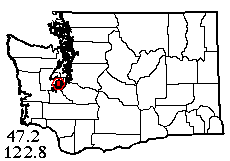 |
![]() 27 II 2020: Wet and cold had prevailed since the 2nd week of November. Not until February of the new year did we have a couple of windows of field weather. On the second of these, Laurel and I actually managed to get into the field again! Our destination was the east side of Hartstene [a.k.a. Harstine] Island (west side visited in 2017). My primary goal was a tract of working forest owned by Manke Timber, which doesn't mind recreational activity if you don't consume timber. We parked by a gated logging road off Ballow Road; all was peaceful, the vegetation was dry, temperatures were cool but soon warmed to shirtsleeve comfort. However, the foliage-dwelling spiders in this locality were definitely a bit sparse. I first swept 5 species from clearcut grass, not bad, and Laurel added 3 more (plus a couple of unwelcome ticks) along the roadside. Young conifers to beat were abundant as usual in such an environment but multiple beating sessions only added 5 more species. In an adjacent mature forest tract, understory (evergreen huckleberry, salal and ferns) was extensive but had few spiders and added no species. At the same site, Laurel tried cone tapping and got nothing. Laurel's best luck at this site was from moss-sifting, but even that was a struggle (both in brush-penetration and sifting effort) to get some good spiders, ultimately adding 9 species. I found a little maple litter to sift but only added 2 more. At this point we only had 24-25 species, and some distinctly suspicious looks from the inhabitants of nearby residential areas, who seem very worried about crime in this remote location.
27 II 2020: Wet and cold had prevailed since the 2nd week of November. Not until February of the new year did we have a couple of windows of field weather. On the second of these, Laurel and I actually managed to get into the field again! Our destination was the east side of Hartstene [a.k.a. Harstine] Island (west side visited in 2017). My primary goal was a tract of working forest owned by Manke Timber, which doesn't mind recreational activity if you don't consume timber. We parked by a gated logging road off Ballow Road; all was peaceful, the vegetation was dry, temperatures were cool but soon warmed to shirtsleeve comfort. However, the foliage-dwelling spiders in this locality were definitely a bit sparse. I first swept 5 species from clearcut grass, not bad, and Laurel added 3 more (plus a couple of unwelcome ticks) along the roadside. Young conifers to beat were abundant as usual in such an environment but multiple beating sessions only added 5 more species. In an adjacent mature forest tract, understory (evergreen huckleberry, salal and ferns) was extensive but had few spiders and added no species. At the same site, Laurel tried cone tapping and got nothing. Laurel's best luck at this site was from moss-sifting, but even that was a struggle (both in brush-penetration and sifting effort) to get some good spiders, ultimately adding 9 species. I found a little maple litter to sift but only added 2 more. At this point we only had 24-25 species, and some distinctly suspicious looks from the inhabitants of nearby residential areas, who seem very worried about crime in this remote location.
Cruising about for other possible sites, we found the historic (1914) island Community Hall building, whose walls added 2 species, and which had some more productive conifer cones with 4 more. Finally, at historic Jarrell Cove Cemetery (with the air cooling off) I gathered a bag of mixed leaf litter to take home and sift warm. This gave me 8 more species (though largely limited to the top and bottom layers in the bag) and a second mature Ozyptila crab spider (Laurel's special interest) for the day. So in the end we got 38-39 species, but I seemingly didn't pick the initial site with my customary care! We dined at "World Famous" Big Bubba's on Highway 3 on our way home. I make bold to deny their claim of "Washington's Favorite Burgers." They were OK, but Mountain High in Easton, or Betty's Place in Toledo (both Wash.) are far superior.
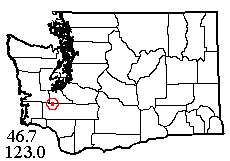 |
![]() 10 III 2020: Using a trip plan I'd researched last fall, we headed for the Grand Mound area (between Olympia and Chehalis) to collect at sites near the hamlet of Galvin. After a stop near the freeway for some unproductive pine cones, we proceeded to our first planned stop, Galvin Bridge over the Chehalis River. The site had grassy fields to sweep, and lo and behold they were dew-free! An adjacent maple forest had litter, moss and understory. And there were several small conifers to beat. The only fly in our ointment was a pile of 3 dead coyotes someone had neatly stacked in mid-field; being visited by flies of their own when the sun came out. Anyway, with field-sweeping, tree-beating and Laurel's combing the railings and sides of the long, spider-rich bridge, it wasn't too long before we had 23 species. Then we moved to sifting, Laurel hoping to sift Ozyptila crab spiders (among others) from moss on tree trunks, but it was I who found the male O. pacifica in maple litter. The sifting brought us to 37 species, and fern understory beating made it 41. Nothing exceedingly rare so far.
10 III 2020: Using a trip plan I'd researched last fall, we headed for the Grand Mound area (between Olympia and Chehalis) to collect at sites near the hamlet of Galvin. After a stop near the freeway for some unproductive pine cones, we proceeded to our first planned stop, Galvin Bridge over the Chehalis River. The site had grassy fields to sweep, and lo and behold they were dew-free! An adjacent maple forest had litter, moss and understory. And there were several small conifers to beat. The only fly in our ointment was a pile of 3 dead coyotes someone had neatly stacked in mid-field; being visited by flies of their own when the sun came out. Anyway, with field-sweeping, tree-beating and Laurel's combing the railings and sides of the long, spider-rich bridge, it wasn't too long before we had 23 species. Then we moved to sifting, Laurel hoping to sift Ozyptila crab spiders (among others) from moss on tree trunks, but it was I who found the male O. pacifica in maple litter. The sifting brought us to 37 species, and fern understory beating made it 41. Nothing exceedingly rare so far.
We hoped our second site would give us some more natural grassland habitat, a tract of public land on Eagle Creek reached by a short walk from the end of the county road. All county right-of-way according to the assessor's map. But locals don't believe it; that short stretch is posted "hunting, fishing, trapping or trespassing for any reason strictly prohibited." Not having a sheriff's deputy with us, we had to move on to the third site, a state clearcut [2014 and 2018 harvests] near Sponenbergh Creek farther west. This, we reached by a rather short but steep climb up a gated road, and used the last sunlight beating trees and sweeping, ultimately giving us 45-47 species. One of Laurel's swept specimens, in poor shape but an adult male, is the only one from the trip I don't immediately recognize. The drive home was uneventful.
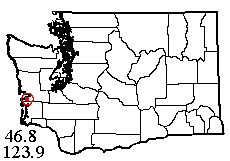 |
![]() 2 IX 2020: Pandemic quarantine followed by an unrelated injury and assorted minor delays had kept me out of the field for nearly 6 months! Finally, Jerry Austin and I set out hopefully on Wednesday morning for the moist coastal plain of Grays Harbor County, one of my regular strategies to find spiders in dry late-summer. I had hoped for distinctive habitats in the lower, tidal reaches of the Johns River (which reaches salt water at the SW corner of the mouth of Grays Harbor). Alas, though much of the tidal reach and associated wetlands are public land, the road that paralleled this stretch provided no access! We had to continue several miles up-river before we ran out of keep-out signs and reached user-friendly timber company land. Parking at a gated junction, I stepped out of the car and inhaled my first lungful of field air, ahhhhh!
2 IX 2020: Pandemic quarantine followed by an unrelated injury and assorted minor delays had kept me out of the field for nearly 6 months! Finally, Jerry Austin and I set out hopefully on Wednesday morning for the moist coastal plain of Grays Harbor County, one of my regular strategies to find spiders in dry late-summer. I had hoped for distinctive habitats in the lower, tidal reaches of the Johns River (which reaches salt water at the SW corner of the mouth of Grays Harbor). Alas, though much of the tidal reach and associated wetlands are public land, the road that paralleled this stretch provided no access! We had to continue several miles up-river before we ran out of keep-out signs and reached user-friendly timber company land. Parking at a gated junction, I stepped out of the car and inhaled my first lungful of field air, ahhhhh!
Available habitats included 9-year-old clearcuts with a good mix of young Douglas-fir, hemlock and Sitka spruce (wear gloves while beating!). A stream crossed the road feeding into a small marsh, surrounded by alder with leaf litter and moss. Lots of grass to sweep along the roads. Up the side road (invisible in the aerial photos) where we parked was a large sedge-fen wetland. All these habitats produced spiders, but I won't know for sure what we got until the end of the month when I'm finally scheduled to get back into my lab! But I'm pretty sure we got a full sample of over 20 species. I thought I spotted Clubiona trivialis and Neoscona arabesca, among others. [In the event we got a nice sample of 32 species. The conifer foliage (both collectors contributing) was most diverse; the litter and moss sifting, most disappointing. Overall, very worthwhile.]
On the way in to our site, we passed an intriguing marshy meadow below the road where it crosses Gold Creek. We stopped there on the way out but accessing the habitat would have required an extremely steep scramble down the high gravel road bank, and I reluctantly decided my injured body wasn't quite ready for that. Sweeping some marshy habitats along the road here got us nothing but one harvestman. So, homeward!
 |
![]() 6 IX 2020: For a long-planned trip with Della Scott, I used a trip plan in the NE foothills of the Olympic Mountains, straddling the Clallam-Jefferson County line near Big Skidder Hill and Little Skidder Hill. Things went wrong, yet in the end I got a sample.
6 IX 2020: For a long-planned trip with Della Scott, I used a trip plan in the NE foothills of the Olympic Mountains, straddling the Clallam-Jefferson County line near Big Skidder Hill and Little Skidder Hill. Things went wrong, yet in the end I got a sample.
First, we missed our ferry, partly because of the ever-confusing Edmonds freeway exit and subsequent back-roads work-around, but we might well have missed it anyway because of quite a long line of prospective passengers. On this occasion the time-honored strategy of traveling on the Sunday of a 3-day weekend (everybody else leaves home Saturday or Friday and comes back Monday, right?) didn't work out. It wasn't only the ferry lines, but we had stop-and-go (mostly stop) traffic from the Hood Canal Bridge all the way back into Port Gamble, and in the evening it backed up at the other end of the bridge! Finally (and largely my fault) we got turned around at the semi-cloverleaf junction of State 104 and US 101, then wasted time searching along 104 for our turnoff from 101! By the time we headed home we'd driven over that 5 miles of 104, 4 times; by that time it actually looked familiar!
Anyway, we did finally arrive at Snow Creek Road's crossing of Trapper Creek, elevation 1200 feet. The nearest acceptable place to park our enormous vehicle was a little distance away, in a small grassy clearing evidently sometimes used as a campsite. My first project was litter-sifting. The only deciduous trees were alders, and litter was pretty sparse (not unusual before leaf-fall), but I gathered a bag of it by the creek and found it fairly spider-rich, with Neon, Wubana atypica, several Usofila, and others plus assorted harvestmen, isopods and myriapods. After the second load of litter, I went back for a load of moss, which also had a fair number of spiders. Then I added a few species by sweeping our little clearing and a bigger one on the far side of the creek; my final habitat at this first site was fern understory, not unusually rich but productive enough.
The sun sinking fast, we selected our final site in a 2010 clearcut, primarily in search of a good conifer foliage sample. Along the road, foliage was dusty and nasssssty blackberry was too-often present, but a narrow fire-break along the clearcut edge gave me the tree foliage access I was looking for. Lots of orbweavers, both here and at the Trapper Creek site. The conifer foliage wasn't as productive as hoped, but I eventually managed to add 6 species, with 2 more (including a lovely little Ero) from salal habitat found at the last minute. This made me reasonably confident of a sample. [In fact I got 26-28 species including a nice series of Neoscona arabesca.]
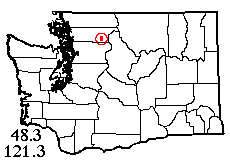 |
![]() 22 IX 2020: For reasons needless to state, we got a late start (around 11 AM), but Jerry and I were finally on our way on the first day of fall. We arrived about 1 at a bridge across remote Tenas Creek, in the Cascades of southeast Skagit County. The medium-sized creek gave us background music. Except for one truck already parked nearby, we saw no one else on the road (which earlier passes through a terrific old growth stand) all day. Unfortunately the 30% chance of rain the previous night had dripped from the sky nearly everywhere, so most of the vegetation (even the conifer needles) was wet. But the mild temperature was good for sifting! I started to sift alder litter, finishing up with one bag of litter from a single cottonwood tree. Five small bags of leaf litter got me about 65 spider specimens, including (I hoped) a nice variety of microspiders. Meanwhile, Jerry had been trying his hand at the abundant moss of the area without a sifter. In late afternoon I let him take over my sifter while I wandered up the road in search of dry conifer branches.
22 IX 2020: For reasons needless to state, we got a late start (around 11 AM), but Jerry and I were finally on our way on the first day of fall. We arrived about 1 at a bridge across remote Tenas Creek, in the Cascades of southeast Skagit County. The medium-sized creek gave us background music. Except for one truck already parked nearby, we saw no one else on the road (which earlier passes through a terrific old growth stand) all day. Unfortunately the 30% chance of rain the previous night had dripped from the sky nearly everywhere, so most of the vegetation (even the conifer needles) was wet. But the mild temperature was good for sifting! I started to sift alder litter, finishing up with one bag of litter from a single cottonwood tree. Five small bags of leaf litter got me about 65 spider specimens, including (I hoped) a nice variety of microspiders. Meanwhile, Jerry had been trying his hand at the abundant moss of the area without a sifter. In late afternoon I let him take over my sifter while I wandered up the road in search of dry conifer branches.
And finding that all the reachable conifer branches were still wet! However, it's for situations like this that I bring two beating nets. The conifer spiders were nice and diverse (including an unusual orbweaver), so even with a lot of unwanted water drops I added about 6 species that way. I did manage to find some semi-dry thimbleberry and ferns and got a small but significant understory sample. Being just about done with the net, I should have got it really wet by sweeping grassy verge, but somehow didn't. I had good hopes for the creek bridge, usually a good habitat, but only added Tetragnatha versicolor there. I had a good go at dead-wood collecting in the forest, but found nothing. Jerry tried under-rock collecting and found only alligator lizards! (Sorry, no lizard photos). In the last 90 minutes before dark, I took over from Jerry on moss sifting and, I hope, added a few more species. The Burger Barn in Darrington had closed early, so we went directly home, too late for a sunset but I hope with a sufficient sample. [28 species including 14 from leaf litter which has clearly made the jump into fall diversity!]
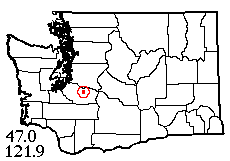 |
![]() 6 X 2020: I had several trip plans I considered viable, and Jerry chose the venerable South Prairie Creek plan for the one day we managed to get out during a long early-October dry spell. This site, several miles east of Wilkeson (Pierce County) in an obscure national forest area, has been tried twice before, once derailed by utterly unpredicted rain, the second time by car damage from hitting a box on the freeway. Anyway, the road was rough (as expected) but not as bad as it could be, and when Jerry had to give up on it there was only a mile or so (uphill, huff puff) to hike. The planned site, a giant grassy clearing on the ridge east of South Prairie Creek, has a curious history. First cut-over sometime before 2000, the part we hiked through is now a well-grown seral alder-conifer forest, but our destination grassland just didn't grow trees! Some trees planted there between 2003-2009 disappeared between May and September '09 (all this info courtesy of Google Time Machine), and now there are some newer, smaller planted Douglas-firs but it's still mostly in grass and catsear.
6 X 2020: I had several trip plans I considered viable, and Jerry chose the venerable South Prairie Creek plan for the one day we managed to get out during a long early-October dry spell. This site, several miles east of Wilkeson (Pierce County) in an obscure national forest area, has been tried twice before, once derailed by utterly unpredicted rain, the second time by car damage from hitting a box on the freeway. Anyway, the road was rough (as expected) but not as bad as it could be, and when Jerry had to give up on it there was only a mile or so (uphill, huff puff) to hike. The planned site, a giant grassy clearing on the ridge east of South Prairie Creek, has a curious history. First cut-over sometime before 2000, the part we hiked through is now a well-grown seral alder-conifer forest, but our destination grassland just didn't grow trees! Some trees planted there between 2003-2009 disappeared between May and September '09 (all this info courtesy of Google Time Machine), and now there are some newer, smaller planted Douglas-firs but it's still mostly in grass and catsear.
Anyway, sweeping the vast steeply-sloping field was the obvious thing to do and in an hour or two it got me a very pleasing 12 species, including a rather big Misumenops crab spider that I don't at all recognize. There were another 12 (7 different from the grass fauna) on the young, sunlit conifer foliage. Did I mention that it was a warm sunny summer-like day here (though foggy elsewhere)? Meanwhile, Jerry had been beating conifers in the shade along the blocked road we hiked up, and that was especially productive, adding 9 more species. I got a few from salal while Jerry disappeared into the welkin seeking more habitats.
Unwilling to wait I knew not how long until Jerry returned, I wrote him a note on a flat piece of light wood (forest notepaper) and hiked back to the car for sifting, having noted much riparian mossy alder there. I sifted 10 spider species from alder litter (and a lot of other stuff including the cool harvestman Taracus pallipes); Jerry returned in time to help sift moss, and had also added a couple from alder foliage. In the end, we had a fine total of 46 species.
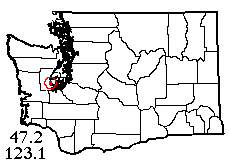 |
![]() 22 X 2020: The weather outlook was lousy for every area in my sheaf of trip plans, except one! That one gave a 2-day window for a pair of sites along U.S. 101 where it skirts the west edge of Shelton, Mason County. Jerry was available the second day and we easily found the tract of maple forest along Goldsborough Creek (more robust at this point than some "rivers") between the highway, Railroad Avenue and a Head Start school. It looked lovely, though the chilly high fog was less inviting. Anyway, the lush fern understory was only moderately dew-damp and I began beating it, finding the spiders sparse but sufficiently diverse to keep me going until my first net was wet, though not soaked. Result, 9 species. Jerry had been working at the moss, finding the spiders similarly sparse, but he eventually got fully 10 species including fine series of Calymmaria emertoni and Dipoena lana, but only 2 mature linyphiids! I thought I'd try some moss too, sifting a bag each from 3 widely separated trees on a discarded truck tire. I added only one spider species! In view of this, I figured the leaf litter was probably too cold (although the sun was burning through by this time), so I gathered a bag of it to take home. Sifting the warmed litter that night, I found it alive with baby isopods, but the only mature spiders were Xysticus pretiosus! Somehow, this lovely-looking site was poor in spiders (20 species for the visit). Oh well, on to the next place…
22 X 2020: The weather outlook was lousy for every area in my sheaf of trip plans, except one! That one gave a 2-day window for a pair of sites along U.S. 101 where it skirts the west edge of Shelton, Mason County. Jerry was available the second day and we easily found the tract of maple forest along Goldsborough Creek (more robust at this point than some "rivers") between the highway, Railroad Avenue and a Head Start school. It looked lovely, though the chilly high fog was less inviting. Anyway, the lush fern understory was only moderately dew-damp and I began beating it, finding the spiders sparse but sufficiently diverse to keep me going until my first net was wet, though not soaked. Result, 9 species. Jerry had been working at the moss, finding the spiders similarly sparse, but he eventually got fully 10 species including fine series of Calymmaria emertoni and Dipoena lana, but only 2 mature linyphiids! I thought I'd try some moss too, sifting a bag each from 3 widely separated trees on a discarded truck tire. I added only one spider species! In view of this, I figured the leaf litter was probably too cold (although the sun was burning through by this time), so I gathered a bag of it to take home. Sifting the warmed litter that night, I found it alive with baby isopods, but the only mature spiders were Xysticus pretiosus! Somehow, this lovely-looking site was poor in spiders (20 species for the visit). Oh well, on to the next place…
My other pre-selected site was a logging road passing close to Johns Lake. Logging company land is usually no problem to access but this time, there was a no-hunting-no-trespassing right by the gate (too bad you can't see those in aerial photos). Phooey! By way of thumbing my nose at authority, I swept grass in the highway right-of-way and beat a few trees I could reach, adding 6 more species in 30-40 minutes. Probably the intended area would have been good!
We had 2+ hours of daylight left, so we cruised around looking for a forest with no signs, and found one along Dayton Airport Road. Not a very prepossessing forest: the trees (Douglas-fir, a few white and lodgepole pine) were toothpick-thick though tall enough, but those by the road had some nice low foliage that added 3 more species for us, plus several others we already had. The closed canopy conifer stand had 3 different kinds of understory (fern, snowberry, salal) in different areas. I added a couple of adult Metellina by sweeping the ferns, but got zero from the promising-looking salal across the road. Jerry found some better salal that added 3 species including a nice adult of the native funnel weaver Agelenopsis oregonensis. Plus one more from moss. In the end, 34-35 species, not so bad but with some very peculiar lacks.
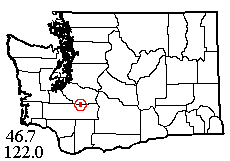 |
![]() 29 X 2020: A brief cold spell was to be interrupted by a couple of warm days, and I again got Jerry to drive on Thursday, this time to Ashford in southeastern Pierce County, along the Nisqually River not far outside Mt. Rainier park. I'd identified a sizeable public land tract between the highway and the river, reached by a public right-of-way between roadside private parcels. We found the inconspicuous, gated access point with little trouble, parked across the highway, and walked in on a grass-and-leaf covered old road. Within a half mile we were in terrain of surprising beauty, with outstanding peace and solitude, amid varied second-growth forest with maple, cottonwood, alder and conifer stands. I stopped at a point where a meadow was visible off to the right, the sun came out, and we started raking in the spiders! Although, as Jerry commented, we did have to work for them, there was plenty to work for. The conifer foliage, with different faunas by the old road and off toward the meadow, gave us a nice start of 14 species. Fern-dominated understory brought it to 19, including colorful Walckenaeria auranticeps and Theridion californicum. Jerry's moss-sifting brought us up to 28, including uncommon Hexura picea; he also found both Taracus and Oskoron harvestmen. My sifting of cottonwood-alder litter brought us to 38, including a nice female of rare linyphiid Drapetisca alteranda. Sweeping in the meadow added one more.
29 X 2020: A brief cold spell was to be interrupted by a couple of warm days, and I again got Jerry to drive on Thursday, this time to Ashford in southeastern Pierce County, along the Nisqually River not far outside Mt. Rainier park. I'd identified a sizeable public land tract between the highway and the river, reached by a public right-of-way between roadside private parcels. We found the inconspicuous, gated access point with little trouble, parked across the highway, and walked in on a grass-and-leaf covered old road. Within a half mile we were in terrain of surprising beauty, with outstanding peace and solitude, amid varied second-growth forest with maple, cottonwood, alder and conifer stands. I stopped at a point where a meadow was visible off to the right, the sun came out, and we started raking in the spiders! Although, as Jerry commented, we did have to work for them, there was plenty to work for. The conifer foliage, with different faunas by the old road and off toward the meadow, gave us a nice start of 14 species. Fern-dominated understory brought it to 19, including colorful Walckenaeria auranticeps and Theridion californicum. Jerry's moss-sifting brought us up to 28, including uncommon Hexura picea; he also found both Taracus and Oskoron harvestmen. My sifting of cottonwood-alder litter brought us to 38, including a nice female of rare linyphiid Drapetisca alteranda. Sweeping in the meadow added one more.
Wanting to move on, I called loudly for Jerry and evoked a surprising echo (in flat forested terrain, what was my voice bouncing off?). Jerry wanted to finish a beat sample, so I walked back to the car and along the highway to Ashford County Park, whose rules prohibit "removal of foliage" but say nothing about spiders. I got one more orbweaver from the restroom building, swept a second Tetragnatha and a surprising fishing spider from the wetland grass around stormwater ponds. Neither here nor at the first site could I get any of the Philodromus rufus universally found on conifer foliage: all replaced by invasive P. dispar. But I did get one P. spectabilis. Total, 43 spider and 8 harvestman species by dark! And spent the day in the most pleasant, peaceful, soul-satisfying surroundings seen this year.
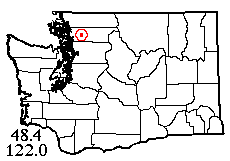 |
![]() 2 XI 2020: Highs in the 60s were predicted, a warmth most unusual for November, so we just had to go collecting again! With a short day (thanks to Standard Time), we settled on the 77-mile drive to Potts Road off the South Skagit Highway, between two of my previous trips with Laurel. The gravel road was neither gated nor rough for a change, and perhaps we should have gone farther, but I was impatient and settled on a site near a rock quarry that let in some warm sunlight. The forest quality was not of the highest, but not too bad. We had barely begun when a chap who'd come to the quarry for target practice spotted our nets and mentioned that he'd done some insect collecting himself (of the large-specimen display type). He didn't mention his name, though. Anyway, Jerry began sifting moss and ultimately got 6 species, though not including any of the little ones Laurel and I nearly always get from moss. I found that while the ferns along the road were wet, only a few feet into the woods they were nicely dew-free, and beat 9 species. Jerry got just one specimen from ferns not among my 9, but it was in Laurel's favorite genus Ozyptila! Conifer foliage was sparse and added no different species. Meanwhile, Jerry had turned over a few pieces of dead wood and just happened to get the day's 2 best specimens: a male of undescribed Cicurina #1, and a big female of Cybaeus morosus which I haven't seen in years.
2 XI 2020: Highs in the 60s were predicted, a warmth most unusual for November, so we just had to go collecting again! With a short day (thanks to Standard Time), we settled on the 77-mile drive to Potts Road off the South Skagit Highway, between two of my previous trips with Laurel. The gravel road was neither gated nor rough for a change, and perhaps we should have gone farther, but I was impatient and settled on a site near a rock quarry that let in some warm sunlight. The forest quality was not of the highest, but not too bad. We had barely begun when a chap who'd come to the quarry for target practice spotted our nets and mentioned that he'd done some insect collecting himself (of the large-specimen display type). He didn't mention his name, though. Anyway, Jerry began sifting moss and ultimately got 6 species, though not including any of the little ones Laurel and I nearly always get from moss. I found that while the ferns along the road were wet, only a few feet into the woods they were nicely dew-free, and beat 9 species. Jerry got just one specimen from ferns not among my 9, but it was in Laurel's favorite genus Ozyptila! Conifer foliage was sparse and added no different species. Meanwhile, Jerry had turned over a few pieces of dead wood and just happened to get the day's 2 best specimens: a male of undescribed Cicurina #1, and a big female of Cybaeus morosus which I haven't seen in years.
A prediction is not the same thing as a promise, alas. I don't think the temperature got anywhere near 60, and in midafternoon, clouds appeared. I felt I'd better sift the leaf litter at once while the spiders were still warm enough to move. The litter fauna was rather low in diversity, but it did add 8 species, making a sufficient if not stunning 25 for the site.
We could have found a few more species at the quarry site, but I had a secondary goal for the day, so the quarry rocks and roadside verge were left untouched. A few miles west was Gilligan Creek, near which Laurel and I had collected in March 2018. At the time, I was unaware that a trail we didn't take would have led us to scenic Gilligan Creek Falls. In the last 2 hours of daylight, Jerry and I wanted to try the hike and maybe add some spider species for that area. Well, we made it to the falls and I have pictures to prove it! Also a few spiders beaten from hanging maidenhair ferns on the cliffs of the waterfall gorge, actually adding 2 species to the prior 25 from that area. And Jerry raised my hair a bit by climbing down to the gorge bottom on a very long aluminum ladder that some unofficial person had left there. (The safety-obsessed county officials think you shouldn't even approach the falls without a hard hat!) But he made it out, and we hiked back to the car in gradually deepening gloom, without ever quite needing our flashlights.
2020 got off to a slow start, thanks to the pandemic. But we got in some good work later!
This page last updated 21 March, 2025